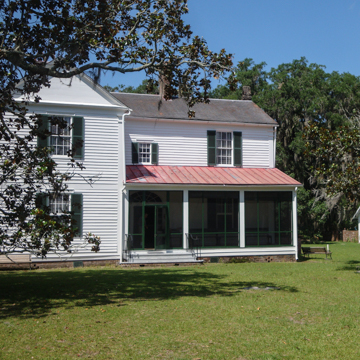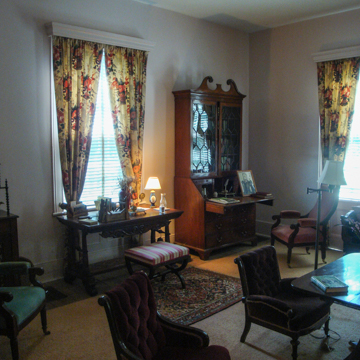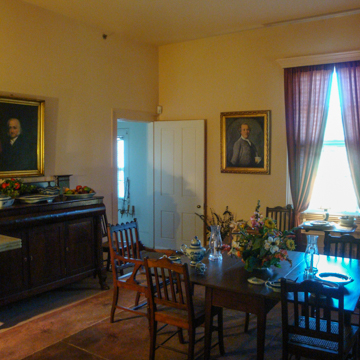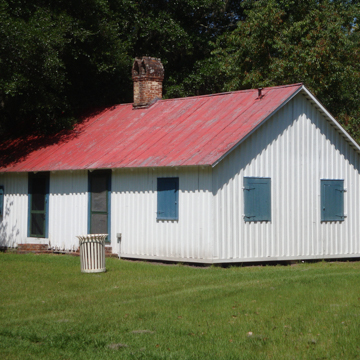The Hofwyl-Broadfield Plantation is located just south of Darien and the Altamaha River. Its preserved plantation house, outbuildings, and surrounding landscape represent the early rice culture of Georgia’s coastal freshwater marshes. In the early 1800s, William Brailsford left Charleston to establish a rice plantation along the Altamaha River. He bought a tract of land called “Broadface,” changed its name to Broadfield, and found success in rice cultivation prior to his death in 1810. Brailsford’s son-in-law, James M. Troup, took over management of the plantation in 1814. Troup was a physician who had studied medicine in Philadelphia and came to Darien in 1812, establishing himself in Glynn County as a planter. He purchased Broadfield in 1834, buying the adjacent New Hope plantation a few years later. Following the example of his brother, who served as state governor between 1823 and 1827, he became prominent in civic affairs. Troup served as an alderman, mayor, and state senator. He ultimately owned 7,300 acres of land, 357 slaves, and homes in Darien and Baisden’s Bluff.
Troup’s eldest son, D. H. B. Troup, managed Broadfield until 1856 when it was divided among Troup’s sons and daughters. This broke the estate up into three parcels: Broadfield, East New Hope, and West New Hope. The latter Ophelia Troup Dent renamed Hofwyl after the Swiss agricultural school that her husband, George Columbus Dent, attended. Ophelia began to build the surviving plantation house at Hofwyl in 1851. Despite improving family fortunes during the 1850s, it was still not finished when the war broke out.
A remarkable feature of the Hofwyl-Broadfield historic site is the landscape along the freshwater marsh, the location of the former rice fields and irrigation canal. Rice fields were prepared in ten- to twenty-acre plots, dug by hand within the outer banks, subdivided by drains or forced ditches into single-acre plots, with each drain having shorter outlets called quarter drains to control water levels. Trunks or floodgates were built into the outer banks in order to maintain an adequate and constant flow while draining and flooding the fields. Rice fields required fresh water, so dikes and flood gates had to be designed to allow fresh water from the Altamaha to flow into the fields during low tides and block salt water from the sea during periods of higher tides, the whole a complex technology of drainage and flood control.
Preparation of the fields and the drainage system involved arduous labor by enslaved workers, who dug ditches eight feet wide and five feet deep, leveled fields, and cultivated the rice. Rice cultivation had been largely reliant on enslaved labor prior to the Civil War. Seeds were planted in the spring, followed by careful management of flooded fields (four floodings) before rice was ready for harvesting in late August or early September. Edward King, in The Great South (1875), described rice culture as “a huge hydraulic machine, maintained by constant warring against the rivers.” In the years following the war, African Americans continued to work the fields as paid laborers. Outbuildings at Hofwyl-Broadfield Plantation, which included a commissary and a pay shed, reflected changes in labor practices after the Civil War.
When it became impossible to continue the cultivation of rice, later generations at Hofwyd-Broadfield started a dairy, which lasted until about 1942. Ophelia Troup Dent was the last heir to the plantation and upon her death in 1973, she left the house to the State of Georgia. The bequest included family heirlooms, antique furniture, and furnishings dating to the 1790s; all the furniture currently displayed in the house are family pieces. The seven outbuildings include a garage/ice house, pay shed, silo foundation, bottling house, dairy barn, commissary, and servant’s quarters. Ruins of the rice mill also remain. In 1979, the Georgia Department of Natural Resources opened the property to the public. Today, the historic site comprises 1,268 acres of land and 696 acres of freshwater marshes. The plantation remains a unique reminder of a now lost early-nineteenth-century rice culture in Georgia.

















